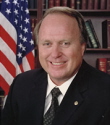Getting to 15 Percent: Two Different Paths for Dean Barkley (’08) and Tim Penny (’02)

Barkley has now all but vanished from the media during a Senate recount of an election for which he nonetheless played a very significant role.
Barkley defied skeptics and academics that thought he would fade into single digits by Election Day. Instead, the former appointed Senator ended up with 15.2 percent of the vote – the largest total for a third party candidate in a Minnesota U.S. Senate race since the DFL merger in 1944.
Though Barkley’s campaign was run much differently than Independence Party candidate Tim Penny’s in the 2002 gubernatorial election, they earned a nearly identical percentage of the vote (16.2 percent for Penny in an election Republican Tim Pawlenty won by 7.9 points). (Penny also endorsed Barkley for his Senate bid).
Indeed, Barkley and Penny took two entirely different paths to reach 15 and 16 percent respectively:
Penny not only reached the 30 percent mark in three-way polling as late as the September before the election, but he also won 7 counties (Waseca, Freeborn, Faribault, Fillmore, Mower, Dodge, Olmsted) and came in 2nd place in 8 more (Steele, Wabasha, Houston, Blue Earth, Le Sueur, Winona, Goodhue, Martin).
Barkley, meanwhile, never eclipsed the 20 percent mark in any public poll, and came in third place in each of the state’s 87 counties on Election Day.
Penny, of course, was able to leverage his base support in the southeastern counties of the state – whose 1st Congressional District he served as a DFLer from 1983 to 1995. Penny won two of those counties with more than 50 percent of the vote (Waseca and Freeborn), earned more than 40 percent of the vote in 5 other counties, and 30+ percent of the vote in 7 more.
Barkley, on the other hand, did not earn more than 30 percent of the vote in any county in the state; his highest tally was 26 percent in Sibley County. However, Barkley impressively tallied double-digit numbers in all but three counties statewide (Houston, Rock, and Pipestone).
Because Penny’s support was regionally based, his votes were stretched thin across the rest of the state: Penny received less than 10 percent of the vote in 11 counties – eight more than Barkley (Roseau, Polk, Clearwater, Kittson, Marshall, Beltrami, Norman, Clay, Red Lake, Wilkin, and Pennington).
Barkley and Penny fared about the same in the state’s most populous counties: 14 percent for Penny in Hennepin compared to 13 percent for Barkley and 12 percent for Penny in Ramsey compared to 13 percent for Barkley.
What does Barkley’s more consistent support statewide tell us about his campaign? On the one hand, it could mean that his base of support was strong – and the fact that his polling numbers were very consistent from late September through Election Day might be evidence of this. On the other hand, as Barkley largely relied on the debates for his media coverage to reach voters, it is possible a substantial segment of his voters across the state were folks turned off by the expensive, nasty fight between Coleman and Franken – as their ads did reach every corner of the state.
Whatever the reason, both Barkley and Penny deserve credit for giving the Independence Party an (uninvited) seat at the table alongside the DFL and the GOP in elections to come.
County-Wide Support for Tim Penny (2002) and Dean Barkley (2008)
| Percent |
Penny
|
Barkley
|
| 50+ |
2
|
0
|
| 40-49 |
5
|
0
|
| 30-39 |
7
|
0
|
| 20-29 |
7
|
17
|
| 10-19 |
55
|
67
|
| 0-9 |
11
|
3
|
